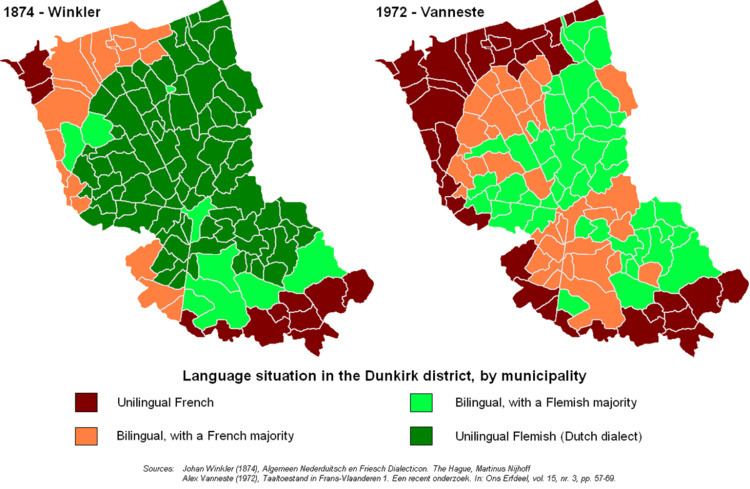Native speakers 1.4 million (1998) | ||
 | ||
Native to Belgium, Netherlands, France Language family Indo-EuropeanGermanicWest GermanicLow FranconianDutchWest Flemish Dialects ZealandicFrench Flemish ISO 639-3 Either:vls – (West) Vlaamszea – Zealandic (Zeeuws) | ||
West Flemish (Dutch: West-Vlaams, French: flamand occidental) is a dialect of the Dutch language spoken in western Belgium and adjoining parts of the Netherlands and France.
Contents
- Phonology
- Plural form
- Verb conjugation
- Double subject
- Articles
- Conjugation of yes and no
- Vocabulary
- False friends
- References
West Flemish is spoken by about a million people in the Belgian province of West Flanders, and a further 120,000 in the neighbouring Dutch coastal district of Zeelandic Flanders (and another 220,000 if Zealandic is included), and 10,000 in the northern part of the French département of Nord. Some of the main cities where West Flemish is widely spoken are Bruges, Kortrijk, Ostend, Roeselare, and Ypres. The dialects of the rest of the Dutch province of Zeeland, Zeelandic, are often included in West Flemish; these are part of a dialect continuum which proceeds further north into Hollandic.
West Flemish is listed as a "vulnerable" language in UNESCO's online Red Book of Endangered Languages.
Phonology
West Flemish phonology differs a lot from the standard Dutch phonology. The best known are the (pre-)velar fricatives g and ch in Dutch (/x, ɣ/), being realised as glottal h - [h, ɦ], and the overall lack of diphthongs compared to Dutch. The following differences are listed by their Dutch spelling, as some different letters have evolved to the same sound in Dutch, but stayed separate sounds in West Flemish. Pronunciations can also differ a bit from region to region.
Due to the non-existent /x/ and /ɣ/ sounds in West Flemish, native speakers of the dialect have to concentrate a lot to pronounce these sounds. This often results in hyper-correction of the /h/ sounds to a /x/ or /ɣ/.
The Dutch language also has many words with an -en (/ən/) suffix (mostly plural forms of verbs and nouns). While standard Dutch and most Dutch dialects don't pronounce the final n, West Flemish typically drops the e and pastes the n to the base word. For base words already ending with n, the final n sound is often prolonged to make the suffix clear. This mute-e is similar to many English words: beaten, listen, ...
The short o ([ɔ]) in words can also be pronounced as a short u ([ʌ]). This happens spontaneously on some words, but other words keep their original short o sounds. Similarly, the short a ([ɑ]) can turn into a short o ([ɔ]) in some words without apparent reason.
The diftong ui (/œy/) doesn't exist in West Flemish, and is (depending on the word) pronounced as a long u ([ʉ]) or a long ie ([i:]). Similar to the ui, the long o ([o]) can turn into an [ø] (eu) on some words, while it becomes a [wo] in other ones.
This transition often shows similarities with English.
Here are some examples showing the sound shifts that are part of the vocabulary:
Plural form
Plural forms in Dutch are made most often by appending an -en suffix, while West Flemish uses the -s suffix on more plural forms. This phenomenon is shared with the Lower Saxon Germanic dialects, and even more prominent in English (where a plural form on -en has become very rare). Under influence of Standard Dutch, the number of people that uses the -s suffix for the plural form on these words diverging from Dutch is diminishing. Younger speakers tend to resort more to the plural form on -en.
Verb conjugation
The verbs "zijn" (to be) and "hebben" (to have) are also conjugated differently.
Double subject
West Flemish often shows a duplicated subject.
Articles
In Dutch, the indefinite article doesn't depend on gender, while in West Flemish, it does. Though this practice is dying, and the gender-independent article more often being used. And similar to English, a connection n is only made when the next word starts with a vowel.
Conjugation of yes and no
Another feature of the West Flemish dialect is the conjugation of ja and nee (yes and no) to the subject of the sentence. This is somewhat related to the double subject, but even when the rest of the sentence isn't pronounced, ja and nee are generally pronounced together with the first part of the double subject. And there's also an extra word: toet ([tut]) which is used for negating the previous sentence but giving a positive answer.
Ja, nee and toet can also always be made stronger by adding a mo- or ba- in front of it. Both mean "but" (and are derived from "but" or "maar" in Dutch), and they even can be added together (f.e. "mobatoet").
Vocabulary
West Flemish inherited many words from Saxon settlers, and later on received loanwords from wool and cloth trade with England. These two categories both differ from standard Dutch, and show similarities with English, and as such, it's difficult to differentiate between both categories.
During the industrial revolution, the trade with French became more important, and many industrial words are French loanwords
False friends
Even when words exist in Dutch and West Flemish, their meaning isn't guaranteed to be the same. This can sometimes cause confusion for native speakers who don't realise these words are used differently.
